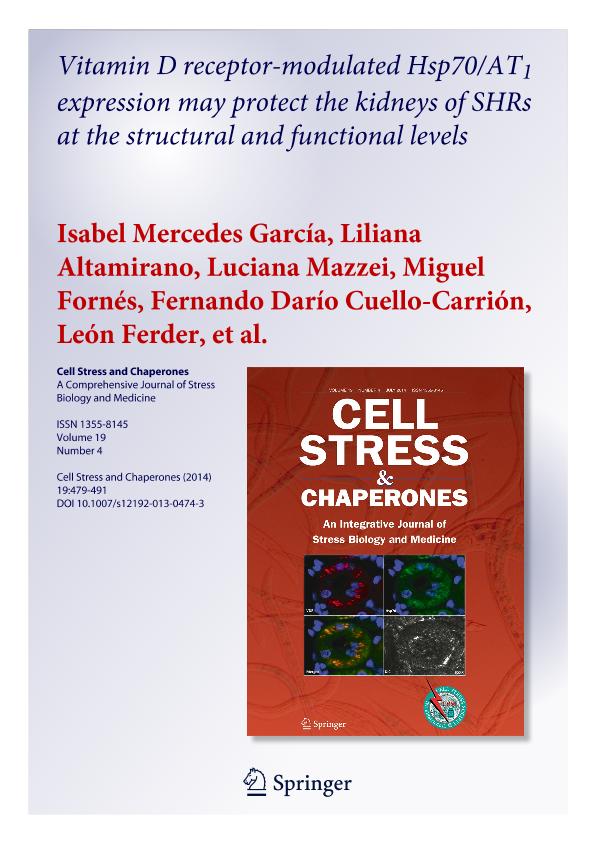Mostrar el registro sencillo del ítem
dc.contributor.author
García, Isabel Mercedes
dc.contributor.author
Altamirano, Liliana
dc.contributor.author
Mazzei, Luciana Jorgelina

dc.contributor.author
Fornes, Miguel Walter

dc.contributor.author
Cuello Carrión, Fernando Darío

dc.contributor.author
Ferder, León
dc.contributor.author
Manucha, Walter Ariel Fernando

dc.date.available
2017-03-30T19:05:39Z
dc.date.issued
2013-11
dc.identifier.citation
Manucha, Walter Ariel Fernando; Ferder, León; Cuello Carrión, Fernando Darío; Fornes, Miguel Walter; Mazzei, Luciana Jorgelina; Altamirano, Liliana; et al.; Vitamin D receptor-modulated Hsp70/AT1 expression may protect the kidneys of SHRs at the structural and functional levels; Springer; Cell Stress & Chaperones.; 19; 4; 11-2013; 479-491
dc.identifier.issn
1355-8145
dc.identifier.uri
http://hdl.handle.net/11336/14541
dc.description.abstract
Background: From hypertension studies, have been well characterized low levels of vitamin D linked to the renin-angiotensin system exaltation as oxidative stress. The heat shock protein 70 (Hsp70) chaperone regulates a diverse set of signaling pathways for cellular oxidative stress responses. In addition, Hsp70 has been shown to protect against Angiotensin II-induced hypertension and exert a cytoprotective effect by down-regulation of Nox4. Aims: Here, we evaluated whether vitamin D receptor (VDR) associated with Hsp70/ AT1 expression may be involved in the mechanism by which paricalcitol exerts renal protection in spontaneously hypertensive rats (SHR). Methods: One-month-old female SRH were treated with vehicle, paricalcitol, enalapril, or combination of both for 4 months. The following were determined: blood pressure; biochemical parameters; fibrosis; apoptosis; mitochondrial morphology; VDR, AT1 receptor, and Hsp70 expression in renal cortex. Results: Blood pressure was markedly reduced by enalapril or combination but not by paricalcitol alone. However, VDR activation and/or enalapril prevented fibrosis (%), the number of TUNEL-positive apoptotic cells (), mitochondrial damage and NADPH oxidase activity, in SHR. Additionally, high AT1 receptor as low Hsp70 expression (immunohistochemical/ immunofluorescence studies) were reverted in renal cortexes from SHR paricalcitol and/or enalapril-treated animals, and these changes were most marked in the combination therapy group. Finally, all parameters recovery, were consistent with an improvement in VDR expression. Conclusions: These data suggest that Hsp70/ AT1 modulated by VDR are involved in the mechanism by which paricalcitol exerts renal protection in SHR. Also, the effect of combining paricalcitol and enalapril on cytoprotection suggest a compensatory/ additive feedback system.
dc.format
application/pdf
dc.language.iso
eng
dc.publisher
Springer

dc.rights
info:eu-repo/semantics/openAccess
dc.rights.uri
https://creativecommons.org/licenses/by-nc-sa/2.5/ar/
dc.subject
Hypertension
dc.subject
Vitamin D Receptor
dc.subject
Angiotensin Ii Type 1 Receptor
dc.subject
Heat Shock Protein 70
dc.subject
Renal Cytoprotection
dc.subject.classification
Patología

dc.subject.classification
Medicina Básica

dc.subject.classification
CIENCIAS MÉDICAS Y DE LA SALUD

dc.title
Vitamin D receptor-modulated Hsp70/AT1 expression may protect the kidneys of SHRs at the structural and functional levels
dc.type
info:eu-repo/semantics/article
dc.type
info:ar-repo/semantics/artículo
dc.type
info:eu-repo/semantics/publishedVersion
dc.date.updated
2016-09-19T18:48:39Z
dc.journal.volume
19
dc.journal.number
4
dc.journal.pagination
479-491
dc.journal.pais
Alemania

dc.journal.ciudad
Berlin
dc.description.fil
Fil: García, Isabel Mercedes. Universidad Nacional de Cuyo. Facultad de
Ciencias Médicas. Departamento de Patología; Argentina
dc.description.fil
Fil: Altamirano, Liliana. Universidad Nacional de Cuyo. Facultad de
Ciencias Médicas. Departamento de Patología; Argentina
dc.description.fil
Fil: Mazzei, Luciana Jorgelina. Consejo Nacional de Investigaciones Científicas y Técnicas. Centro Científico Tecnológico Mendoza. Instituto de Medicina y Biología Experimental de Cuyo; Argentina. Universidad Nacional de Cuyo. Facultad de Ciencias Médicas. Departamento de Patología; Argentina
dc.description.fil
Fil: Fornes, Miguel Walter. Consejo Nacional de Investigaciones Científicas y Tecnicas. Centro Cientifico Tecnologico Mendoza. Instituto Histologia y Embriologia de Mendoza ; Argentina
dc.description.fil
Fil: Cuello Carrión, Fernando Darío. Consejo Nacional de Investigaciones Científicas y Técnicas. Centro Científico Tecnológico Mendoza. Instituto de Medicina y Biología Experimental de Cuyo; Argentina
dc.description.fil
Fil: Ferder, León. Ponce School of Medicine and Health Sciences. Department of Physiology and Pharmacology; Puerto Rico
dc.description.fil
Fil: Manucha, Walter Ariel Fernando. Consejo Nacional de Investigaciones Científicas y Técnicas. Centro Científico Tecnológico Mendoza. Instituto de Medicina y Biología Experimental de Cuyo; Argentina. Universidad Nacional de Cuyo. Facultad de
Ciencias Médicas. Departamento de Patología; Argentina
dc.journal.title
Cell Stress & Chaperones.

dc.relation.alternativeid
info:eu-repo/semantics/altIdentifier/url/http://link.springer.com/article/10.1007%2Fs12192-013-0474-3
dc.relation.alternativeid
info:eu-repo/semantics/altIdentifier/doi/http://dx.doi.org/10.1007/s12192-013-0474-3
Archivos asociados
